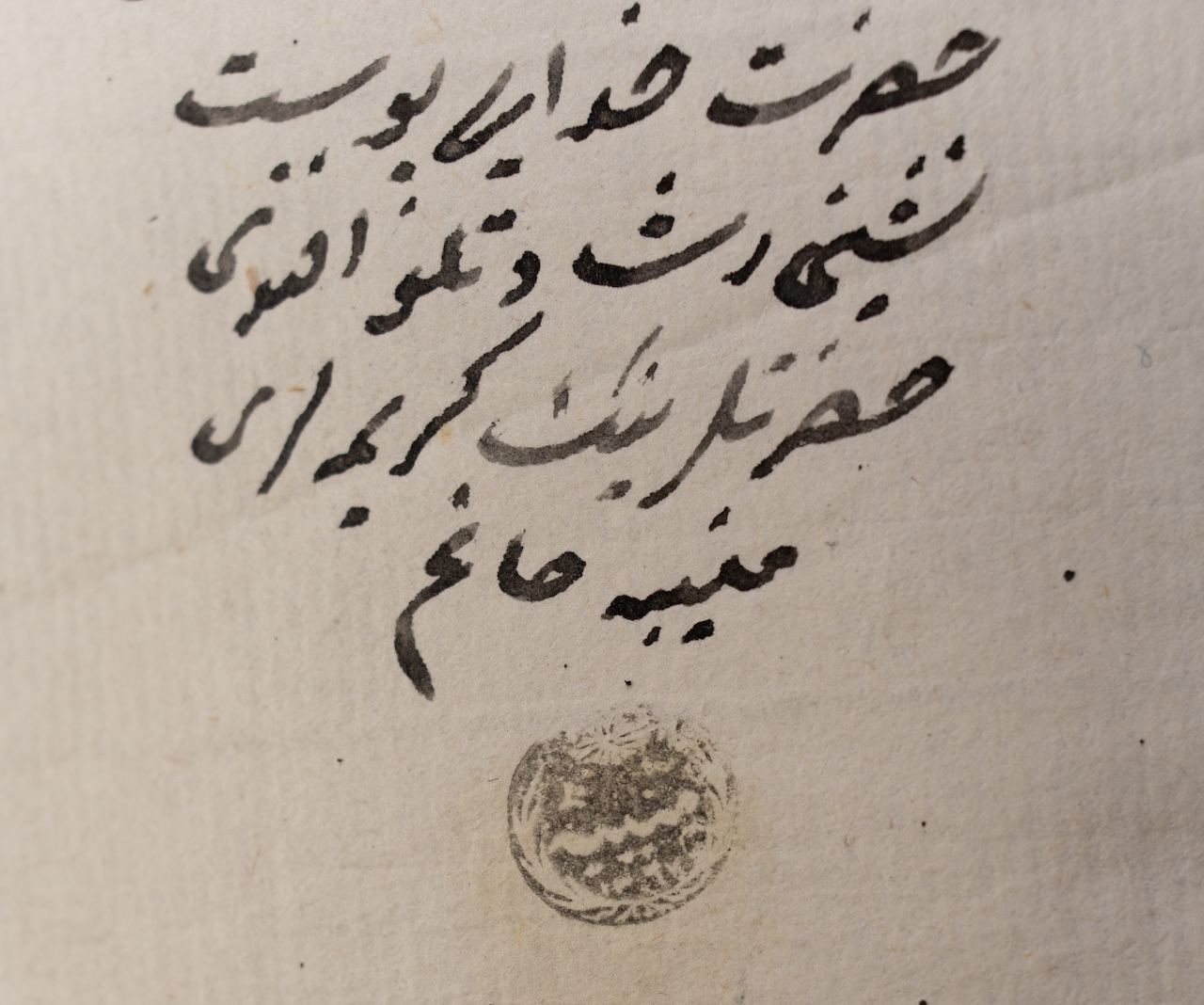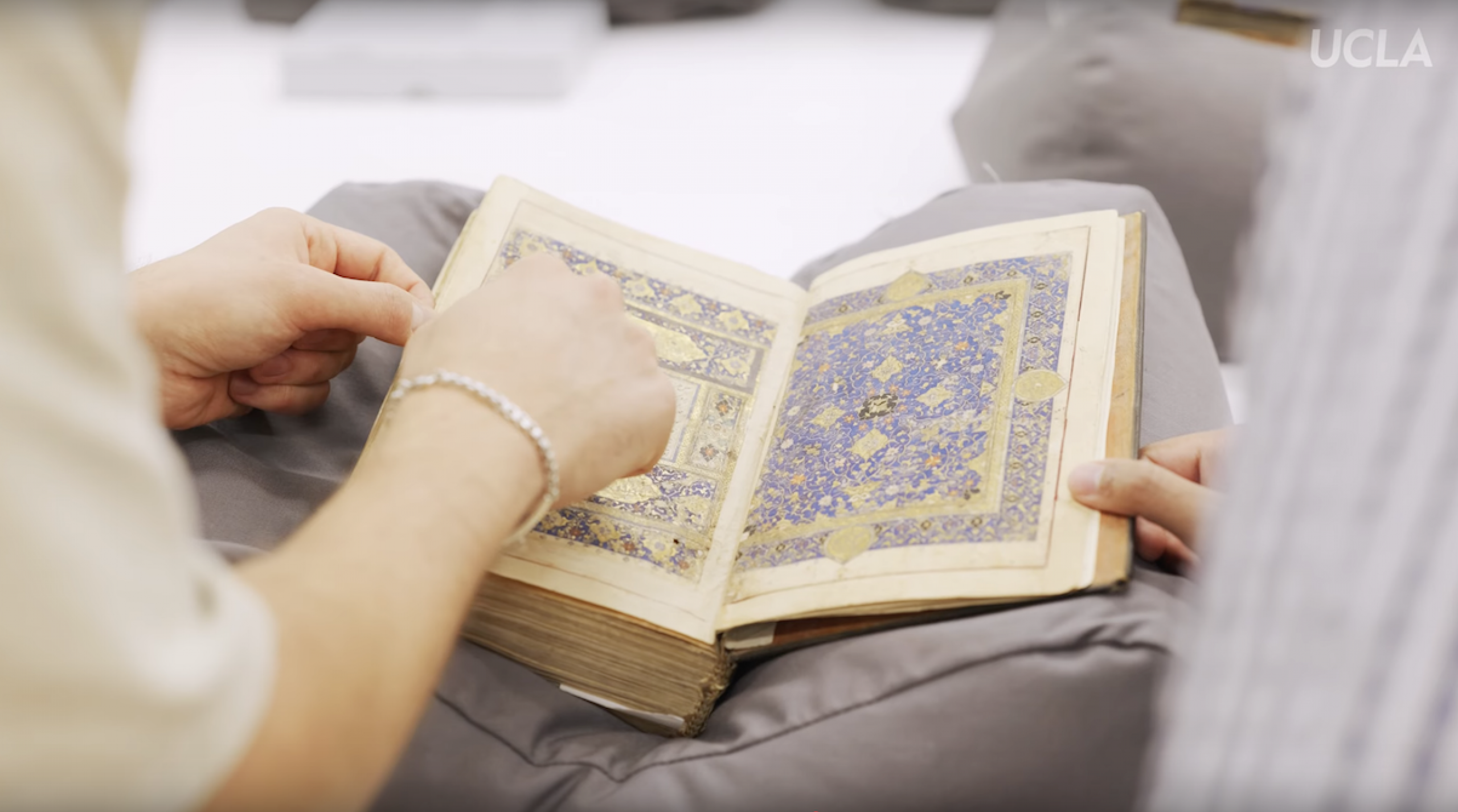More Information
UCLA Library stewards the second-largest Islamicate and Arabic-script manuscript collection in North America. Through its ongoing Islamicate Manuscript Initiative(opens in a new tab), the Library and its partners are working to individually describe and conserve thousands of manuscripts within its collection to make them accessible to scholars and the broader public.
This article highlights the practice of Muslim women endowing individual manuscripts, and introduces examples of these manuscripts held in UCLA Library Special Collections.
Introduction
For most of its history, the Islamic textual tradition was transmitted through handwritten manuscripts. The production and preservation of these manuscripts depended upon a vast infrastructure of scribes, patrons, intellectuals and many others. Several manuscripts within UCLA Library’s collections contain endowment statements (waqfiyah) from a range of Muslim women, including a descendant of the celebrated Sufi poet Rumi (d. 672 A.H. / 1273 C.E.), the grandmother of a Safavid emperor, as well as others who are little known within the historical record. These statements show how such women actively patronized Islamic manuscript culture and scholarship by literally inscribing their names into the pages of these manuscripts.
In Islamic law, endowing manuscripts made them inalienable, forbidding their sale, barter, or use as collateral. Given the monetary value of manuscripts, this practice was intended to safeguard the manuscripts within a mosque, college, Sufi lodge, or private collection. It was also considered a pious act, aligning with the Islamic concept of a recurring charity (sadaqah jariyah), where the benefactor gains spiritual rewards as others benefit from their charitable endowment (waqf). By endowing manuscripts, patrons intended to gain spiritual or otherworldly rewards for supporting the proliferation of knowledge or the worship of fellow believers.
Since manuscripts were expected to outlast - in physical terms - the individuals who endowed them, endowments were also expected to form a source of blessing for the patrons after they passed away. Endowment statements were therefore often written with a strong awareness of human mortality, coupled with prayers for the forgiveness and salvation of the patron. Eschewing anonymity, patrons would write their names within the pages of a manuscript so they could be remembered and prayed for by name. The statements were meant not only for people around them, but for readers in the future (like us!).
A Collection of Poetry for Fatimah Khanum’s Sufi Lodge
وقف الحاجة فاطمة خانم من أولاد حضرت مولانا قدس سره الأعلى لذرية جدها الأسعد قرناً بعد قرن اللهم تقبل منها بلطفک و اعف عنها بفضلک واغفر لها برحمتک يا ارحم الراحمين بحرمة الشفيع الأمين آمین
The endowment of the Pilgrim Fatimah Khanum, from the descendants of the Esteemed Mevlana [Rumi] — may his sublime soul be sanctified — for the progeny of her most felicitous grandfather, century after century. O Allah, accept it from her by Your kindness, pardon her by Your bounty, and forgive her by Your mercy, O Most Merciful of the merciful, by the sanctity of the trustworthy intercessor. Ameen.

This manuscript was endowed in 1104 A.H. (1692-1693 C.E) by the Ottoman Sufi mystic al-Hajjah Fatimah Khanum (Turkish: Hace Fatma Hanım) (d. 1122 A.H. / 1710 C.E.), a descendant of the renowned Sufi poet and mystic Jalal al-Din al-Rumi. Fatimah Khanum, along with her mother Kamilah Khanum and brother Huseyin Çelebi, managed the local Sufi lodge of Rumi’s Sufi order, known as the Mevlevi order, from 1650 to 1689 in Kutahya, a city in Anatolia. Fatimah Khanum dedicated this manuscript to her family’s descendants and for the devotees of the Sufi order, revealing her concern to ensure their Sufi lodge (also known as the Erguniyye Dergâhı) would provide access to such anthologies of poetry.

The volume contains poetry in Persian and Turkish from over 20 different poets, including selections from Sa’di (d. 13th century C.E.), Khayali (d. 850 A.H. /1447 C.E.), Nizami (d. 596 A.H./ 1209 C.E.), Nijati (d. 914 A.H. / 1509 C.E.) and Qabuli (Kabuli) (d. 1000 A.H. / 1591 C.E.), whose name appears on the tail of the textblock. The colophon dated 992 A.H. (1584 C.E.) identifies the scribe as Davari ibn Azmi Bey el-Gedusi (Gedizli), himself a poet whose poetry also appears within the volume. Included near the end of the manuscript is an excerpt from a Turkish rendition of ’Aja'ib al-Makhluqat, a text on Islamic cosmography.
As a poet who is also said to have composed her own compilation (diwan) of poetry, Fatima Khanum likely consulted this manuscript herself. It could also have functioned as a repertoire and reference for poetry recitation in gatherings at their Sufi lodge. Since it included several poets from Gediz, a nearby town in the Kutahya Province, it likely held greater significance as a repository of local poetry as well. Altogether, it shows how Sufi establishments provided access to manuscripts for those who otherwise could not afford to purchase them.


(وقف الحاجة خانم من بنات حضرت مولانا قدس سره للفقراء المولوية تكية كوتاهية حسبه لله تعالى سنة أربع ومائة وألف)
A Scholar’s Light: Rahimah Khatun’s Gift for a Friday Mosque

This manuscript was endowed by Rahimah Khatun al-Khawarizimiyah, daughter of Yusuf, in 1124 A.H. (1712-13 C.E.) Her endowment statement stipulates that the manuscript be used to teach and preach within a newly established chair at the Devlet Han Camii, a Friday mosque built in the 14th century in the Anatolian city of Yalvaç. There is otherwise no information readily available about Rahimah Khatun.
Anwar al-Tanzil wa-Asrar al-Ta’wil (The Lights of Revelation and the Secrets of Interpretation) was one of the most popular commentaries of the Qur’an, taught historically throughout many pre-modern Muslim societies, including the Ottoman and Mughal empires. Written by Qadi Nasir al-Din al-Baydawi (d. 719 A.H. / 1319 C.E.), who lived in the cities of Fars and Tabriz (in modern-day Iran), this would be an attractive text to endow, since it could be expected to be actively used by the town’s imam to teach local residents. The manuscript itself was copied a century earlier in 989 A.H. (1581-82 C.E.) and displays extensive marginal notes in a number of different hands, as well as an aesthetically pleasing illuminated floral headpiece.

The Book of Healing for Uskudar’s Sufi Lodge by Munibah Khanum

This manuscript was endowed by Munibah Khanum (Turkish: Münibe Hanım). Munibah Khanum’s family managed the famed ‘Aziz Mahmud Hudayi Sufi lodge in Uskudar, Istanbul of the Celvetiyye (Jelveti) Sufi order. From biographical sources, we learn that she was the daughter of Mehmet Ruşen Tevfikî Efendi (d.1309 A.H. / 1891 C.E.), the longtime head (postnişin) of the lodge from 1842-1891. What distinguishes her manuscript is that she has her personal stamp throughout the manuscript, with the date 1267 A.H. (1850-51 C.E.).
The text itself, al-Shifa bi-Ta‘rif Huquq al-Mustafa (The Book of Healing through Recognition of The Rights of the Chosen One), was a popular work on the biography and virtues of the Prophet Muhammad by the Andalusian jurist Qadi ‘Iyad (d. 544 A.H. / 1149 C.E.). It had since acquired sacred significance of its own; owning a copy of this text was believed by some to provide spiritual protection.

This particular manuscript was copied by Sayyid Ahmad Halim ibn Muhammad Sadiq in 1149 A.H. (1736 C.E.), with watermarked European paper serving as the primary writing surface. Its binding consists of an outer flap typical of Islamic bindings, as well as red-orange hued paper displaying a running teardrop pattern pasted to the cover. Such admixtures of European and Islamic bookmaking practices and materials were common in this period.
The Provision of Seekers: In Memory of Lady Aminah from Sidon

Fatimah Khanum, the pearl of virtue and gem of refinement, daughter of the late governor of Sidon Hajj Sulayman Pasha, has duly and lawfully endowed, dedicated, and donated this blessed book, placing its divine reward upon the soul of the humble woman in need of her Lord’s mercy, the Lady Aminah, consort of cousin Sayyid Abd Allah Pasha, the former governor of Sidon, hoping thereby in reward from the Generous Sovereign Lord, under the condition that the book may not be sold, pawned, or exchanged. Whoever alters it after hearing this, the sin shall be upon those who alter it; indeed God is All-Hearing, All-Knowing. Year 1251, on the 29th of Rabi’ al-Akhir.
The years leading up to Fatimah Khanum’s 1251 A.H. (1835 C.E.) waqf witnessed several profound changes to the political order of the Levant. The Ottoman Mamluk system in Fatimah’s home province of Sidon (modern-day Lebanon), under which enslaved people were imported to lead the administrative and military structures of provincial governance, had come to an end by the rule of the very same Abd Allah Pasha (r. 1823-1832), who is identified as Fatimah’s cousin in the endowment. His predecessor, Sulayman Pasha (r. 1805-1819), identified in the waqf as Fatimah’s father and governor of Sidon, was a Georgian mamluk who had previously served under the formidable governor Ahmad Pasha al-Jazzar (r. 1777-1804). A series of failed revolts against al-Jazzar, including one briefly tied to Sulayman Pasha, heralded the beginning of the end of a centuries-old system.
Fatimah Khanum’s manuscript endowment provides an interesting glimpse into the social history of the late-Ottoman Levant. Fatimah’s gesture of charity on behalf of Aminah, the consort of Abd Allah Pasha, reveals a deeper affinity between the families of Sulayman Pasha and Abd Allah Pasha (who appear as uncle and nephew, despite not having actual family ties). It also testifies to the role women played in the endowment of landed property, wealth and personal possessions throughout the history of Ottoman Mamluk governance in Egypt and the Levant.

The book itself, entitled Ghunyat al-Talibin wa-Munyat al-Raghibin (The Provision of the Seekers and Desire of those Who Yearn), is a 15-chapter primer on the science of Qur’anic recitation (‘ilm al-tajwid) authored by the Egyptian Muhammad ibn Qasim al-Baqari al-Shafi’i (d. 1111 A.H. / 1699 C.E.). No location or institution was specified within the endowment, which may point to its use within a private collection. Studies on tajwid appeared in both private and institutional settings, from personal libraries to mosques.
The physical features of the manuscript point to 19th-century technological developments: endpapers and supports displaying intricate arrangements of printed English and Ottoman text, as well as European machine-made paper displaying the watermarks “Checchi” and “Giovanni,” all accompany a gold illuminated headpiece. Taken together, the material attributes and waqf statement of the codex subtly reflect broader shifts in both political power and industry.
Illuminative Philosophy Gifted by a Royal Matriarch

This manuscript was endowed in 1057 A.H. (1647 C.E.) by Hurinaz Khanum, who most likely was the grandmother of the Safavid emperor Shah Abbas II (r. 1642-1666). Hurinaz (also: Hurinam) endowed a madrasah in the Safavid capital of Isfahan, the Madrasah-i Jaddah-i Buzurg (est. 1647-1648), and this copy was likely part of its manuscript collection. She wrote in her statement that this manuscript was dedicated to students who lived in the madrasah and “others from the people of faith,” with the condition that they do not take it outside the city.
The waqf attests to both Hurinaz Khanum’s support for the founding of the madrasah and the content of its intellectual life.

Sharh Hikmat al-Ishraq (Commentary on the Philosophy of Illumination) was a well-known commentary by Qutb al-Din Shirazi (d.710 A.H. / 1311 C.E.) on the foundational text of the mystical and philosophical school of Illuminationism, Hikmat al-Ishraq, written by Shihab al-Din Yahya ibn Habash Suhrawardi (d. 587 A.H. / 1191 C.E.). Supporting the text is an intricate and colorful writing surface, with leaves dyed various shades of blue, purple and burnt orange. The binding further features a scalloped mandorla displaying the embossed image of a swan spreading its wings.
Interested in viewing these texts in person? Visit the library research guide(opens in a new tab) on Middle East Studies for more information on accessing UCLA Islamicate Manuscript Collections.


